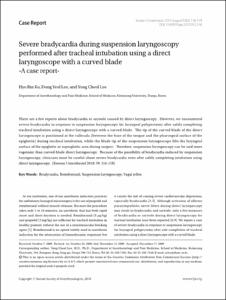KUMEL Repository
1. Journal Papers (연구논문)
1. School of Medicine (의과대학)
Dept. of Anesthesiology & Pain Medicine (마취통증의학)
Severe bradycardia during suspension laryngoscopy performed after tracheal intubation using a direct laryngoscope with a curved blade -A case report-
- Keimyung Author(s)
- Lee, Yong Cheol
- Journal Title
- Korean Journal of Anesthesiology
- Issued Date
- 2010
- Volume
- 59
- Issue
- 2
- Abstract
- There are a few reports about bradycardia or asystole caused by direct laryngoscopy. However, we encountered severe bradycardia in response to suspension laryngoscopy for laryngeal polypectomy after safely completing tracheal intubation using a direct laryngoscope with a curved blade. The tip of the curved blade of the direct laryngoscope is positioned at the vallecula (between the base of the tongue and the pharyngeal surface of the epiglottis) during tracheal intubation, while the blade tip of the suspension laryngoscope lifts the laryngeal
surface of the epiglottis or supraglottic area during surgery. Therefore, suspension laryngoscopy can be said more vagotonic than curved-blade direct laryngoscopy. Because of the possibility of bradycardia induced by suspension laryngoscopy, clinicians must be careful about severe bradycardia even after safely completing intubation using direct laryngoscopy.
- Keimyung Author(s)(Kor)
- 이용철
- Publisher
- School of Medicine
- Citation
- Hyo Bin Ko et al. (2010). Severe bradycardia during suspension laryngoscopy performed after tracheal intubation using a direct laryngoscope with a curved blade -A case report-. Korean Journal of Anesthesiology, 59(2), 116–118. doi: 10.4097/kjae.2010.59.2.116
- Type
- Article
- ISSN
- 2005-6419
- Appears in Collections:
- 1. School of Medicine (의과대학) > Dept. of Anesthesiology & Pain Medicine (마취통증의학)
- 파일 목록
-
-
Download
 oak-aaa-03407.pdf
기타 데이터 / 104.91 kB / Adobe PDF
oak-aaa-03407.pdf
기타 데이터 / 104.91 kB / Adobe PDF
-
Items in Repository are protected by copyright, with all rights reserved, unless otherwise indicated.